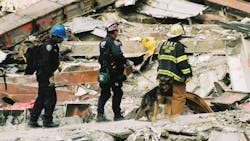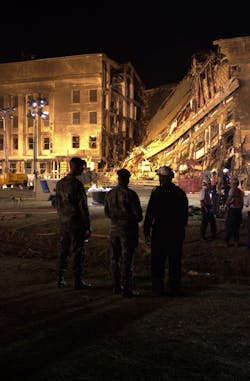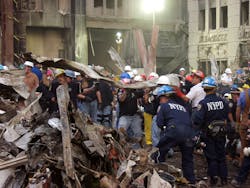They Are Not Forgotten
September 11, 2001. At 8:46 a.m., a hijacked commercial airplane crashes into the North Tower of the World Trade Center in Manhattan, New York City. At 9:03, a second hijacked plane crashes into the South Tower. Both towers eventually collapse. At 9:37, a third hijacked plane crashes into the West side of the Pentagon in Washington, D.C. At 10:07, a fourth hijacked plane crashes into a field in Somerset County, Pennsylvania, after passengers attempt to overpower the hijackers and regain control of the flight.
Americans know these horrifying acts of terror all too well. Between all four crashes, just under 3,000 people were killed that morning. When remembering the events of 9/11, understandably, the focus is often on the attacks, rather than the painstaking efforts of first responders and others to rescue who they could, and recover those who did not survive.
After American Airlines Flight 11 and United Airlines Flight 175 were flown into the North and South Towers of the World Trade Center, first responders from NYPD, FDNY and the Port Authority of New York and New Jersey Police Department sprang into action. Immediately after the North Tower was hit, evacuations began. At the time it appeared this may have been an accident and the South Tower was not initially evacuated. It took less than 20 minutes for it to be made clear this was an intentional act, as the South Tower was struck in the same manner. As the morning unfolded and two other deadly crashes occurred, it became certain these were coordinated attacks against the American people. Just before the South Tower was hit, an evacuation order was issued. Hundreds of people were killed in each impact, but that was only the start of the destruction. Fires roared, trapping people in the upper floors. As those unable to escape were faced with certain death, thousands fled the buildings, and hundreds of police officers and firefighters raced towards them. As the severity of the situation began to set in, things got drastically worse. At 9:59, the South Tower collapsed, followed by the North Tower roughly 30 minutes later. Nearly everyone inside or close to the buildings at the time of the collapses were killed almost instantly, with very few exceptions. Twenty-three people were able to escape the debris, several of them first responders, but approximately 2,600 people died. With such a large number of casualties, the recovery efforts would be seemingly endless, but that did not stop emergency personnel, military members, countless engineers, volunteers, and over 400 dogs from digging through the rubble, searching for the remains of victims. 20 years later, the remains of victims are still being identified, with nearly 40% of victims still needing identification. Forensic biologists are using bone material to obtain DNA cells to identify remains so they can be returned to family members. This process has not stopped since 2001 and there are more than 1,000 sets of unidentified remains left as of recent estimates. It may be unbelievable, but two decades after the attacks, recovery efforts are still in progress.When tragedy strikes on American soil, no matter how great, our first responders will always be there to preserve life. In the unfortunate circumstance there is loss of life, they will not give up until every step is taken to recover the deceased. By the time the scenes were cleared, 343 firefighters, 23 NYPD officers and 37 Port Authority officers lost their lives, and many more have passed away since, due to a multitude of health problems caused by responding to the scenes. Undoubtedly however, countless civilian lives were saved thanks to the heroic responders who put their lives on the line against the most insurmountable odds.
About the Author

Officer Brendan Rodela, Contributing Editor
Brendan Rodela is a Sergeant for the Lincoln County (NM) Sheriff's Office. He holds a degree in Criminal Justice and is a certified instructor with specialized training in Domestic Violence and Interactions with Persons with Mental Impairments.



